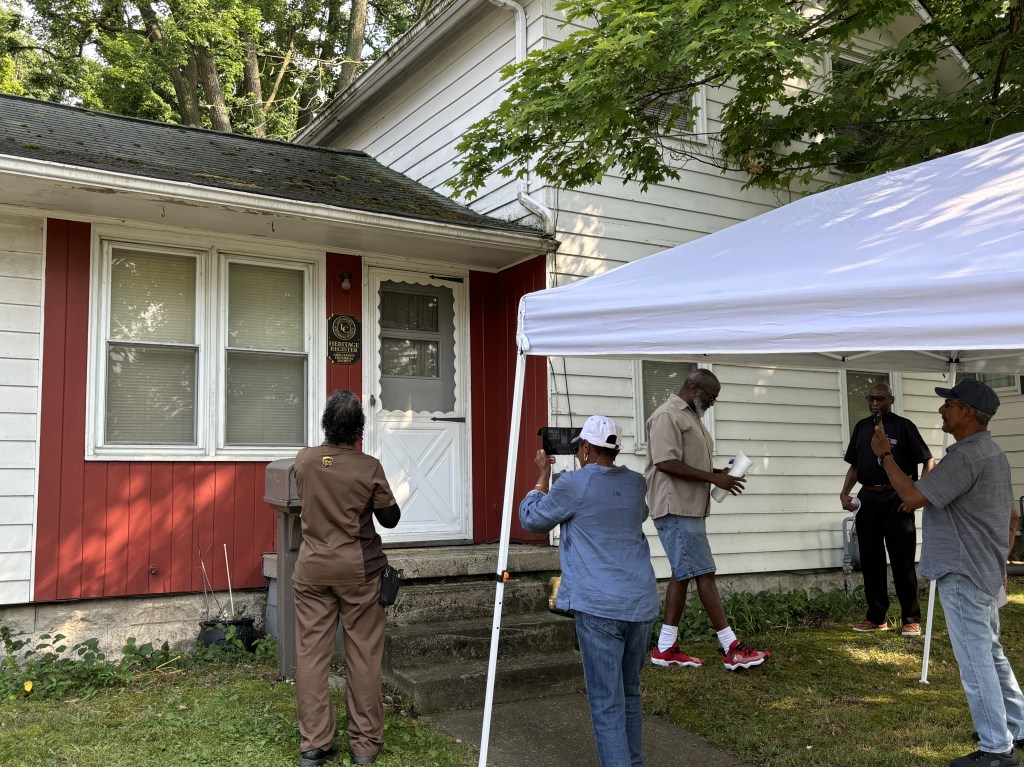Visitors tour the Lake County Historical Society’s new Heritage Register Market at 241 W. Jackson St. in Painesville during the Juneteenth commemoration and dedication ceremony. (Bryson Durst — The News-Herald)
Brian Jones grew up learning about Painesville’s history through Sunday drives with his father and conversations with prominent members of the city’s black community, and now he’s using that information to create a local African-American historic district.
The historic district is one of the projects Jones is involved in as part of the Greater Painesville Underground Railroad Free Cultural Preservation Project, and he recently hosted a tour of the proposed district and celebrated the unveiling of a historical marker at a local home during Juneteenth celebrations.
The celebration began at 241 W. Jackson St. The Lake County Historical Society recently added the home to its Cultural Heritage Register.
Jones said the house was built in 1850. He focused on the life of resident’s grandmother, Hilda P. Aston, who lived in the house from 1966 until she moved into a nursing facility.
Aston was born in Georgia in 1927 and later moved to Painesville where she worked for IRC Fibers, he said. He emphasized her Christian faith and her involvement with her church, Elks lodge and family.
“In honoring Hilda’s legacy, we are reminded that our history is a tapestry of resilience, faith and service,” Jones said. “Let us reintroduce, understand and apply these principles to our lives today. It is through the truths revealed in stories like Hilda’s that we find the strength to heal and the courage to restore our communities.”
Amy Kapostasi, president of the historical society, said to get historic status, homeowners can request an application from the center. Once the application is returned, an architect will come and verify that the home is a historic landmark.
 The Lake County Historical Society’s Heritage Registry plaque is shown moments after it was unveiled during a Juneteenth commemoration and celebration event at 241 W. Jackson St. in Painesville. (Bryson Durst — The News-Herald)
The Lake County Historical Society’s Heritage Registry plaque is shown moments after it was unveiled during a Juneteenth commemoration and celebration event at 241 W. Jackson St. in Painesville. (Bryson Durst — The News-Herald)
Jones then led attendees on a walk through the proposed historic district, which he said would include the Miracle Revival Ministries building at 182 W. Jackson St., St. John Baptist Church at 361 W. Jackson St. and several homes in between.
He added that he hopes the area will receive recognition from the Lake County Historical Society, the Ohio Historic Preservation Office and the National Register of Historic Places.
“We’re still in the very early stages of building the infrastructure and strengthening the organizational capacity so we can start to take some of the next steps,” Jones said.
Speaking about Miracle Revival, Jones said the building was constructed in the early 20th century, with funds raised by a number of women who lived on Jackson Street and nearby Matthews Street.
Further west, he highlighted the homes of Wendell Walker, William Rucker and Mildred Rucker, who once lived in the city.
Jones said Walker was the first African-American to work as a radiologist in the county hospital system and was one of the first African-Americans to serve on the Painesville City Council.
City spokeswoman Kathleen Sullivan and Parks Superintendent Steven Hubbell added that the city has previously dedicated butterfly gardens to Walker around the city’s veterans memorial and the former concession building at Kiwanis Recreation Park.
William Rucker began working at Lake County Memorial Hospital in 1938 and became Lake County’s first African-American doctor, according to an online historical society post written by Dan Maxson and Virginia Jeschelnig, who added that Mildred Rucker mentored many local children.
Jones described the couple as a “dynamic social activist team.”
The tour ended at St. John Baptist Church, whose current building was built in the 1950s, Jones said in a news release from his Underground Railroad Preservation Project, adding that the church’s congregation has a 135-year history.
In addition to preserving St. John and creating a historic district, Jones said the preservation project aims to add memorials to “significant Black churches, homes and businesses.”
He listed other goals as establishing the Lake County African American Cultural Center at the Lake County Historical Society, establishing the Greater Painesville African American History Project to teach local African American history, and investigating Underground Railroad sites in Painesville to “challenge the erasure of preserving African American history and culture.”
Jones said the project also seeks to “encourage and inspire people in African-American culture to apply for heritage family plaques” and share their family stories. He added that people can also reach out to the Lake County History Center for help.
He also offered to help the family put their story together and said he could be contacted at 440-296-5073.
Kapostasi expressed his appreciation for Jones’ work.
“He’s very knowledgeable about the history of Painesville, particularly the African-American history of Painesville, so it’s nice to be able to work with him and some of the churches,” she said.
“We have documents and things like that about black history, but we don’t have the documents and the stories that our African-American neighbors and churches can tell us, and we want them to share that because it’s part of Lake County history,” Kapostasi added.


